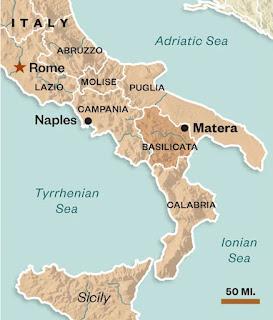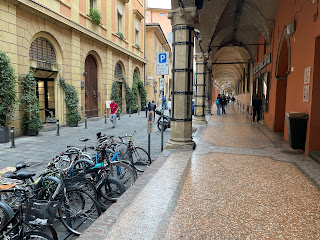Biking the Parma Factory Food Trail
Today was one of those days that keep us coming back to Italy for more. We took the train to Parma and went on a 34-mile bike ride through its countryside to experience its claim to fame: a tour of its DOP food products.
This area of Italy is well connected by train - making it easy to catch a train to Parma. One would think. Our Italy train riding skills were a bit rusty and we failed miserably - no, pathetically is a better word - on our first attempt. We missed our train … and for no good reason. We arrived to the train station plenty on-time, with a solid 20-minute buffer. However, when our high-speed train pulled up to the platform, we just didn't get on. When it left without us we stared at each other completely dumbfounded! If there is an excuse worthy of such idiotic behavior, we would claim it was because no one got on the train. About five people went up to the train attendant and he shooed them away. I thought we were being polite Americans, waiting for him to invite us on - but instead he shut the doors and left. Needless to say, we won't be letting that happen again. You might find us in etiquette jail but next time we will just be "those" people and ignore the obvious. At least then we won't miss our fancy business class train. Somehow, we managed to get on the next train without any further dense behavior.
The Emilio Romagna region holds the record for DOP and IGP products. Probably the most famous DOP food in the region is Parma ham, aka Prosciutto. The other most famous DOP food in the region is Parmigiano Reggiano. These are the two reasons we were on a train to Parma.
What exactly is the meaning of DOP? As you know, sparkling wine can only be called champagne if it comes from that region in France, so you're already familiar with the EU's copyright law on foods: Protected Designation of Origin (DOP). DOP protects the authentication of a food's unique characteristics, linked to their geographical origin as well as traditional know-how. (IGP is a less-strict qualification.)
Looking for something unique to do in the area, I discovered Davide and his Bike Food Stories. His 6-hour private tour, "King of the Cured Meats and Its Court" takes you by bike on rural, low-traffic roads near the base of the Apennine Mountains to a Parmigiano Reggiano cheese factory and then Prosciutto of Parma production site. After all that intense pedaling and learning, you relax and enjoy a lunch of these typical products.
If you want to visit a Parmigiano Reggiano cheese factory and Parma Ham production site, located in the rural area outside of Parma, then your only options are to rent a car (or driver), go on a bus tour … or ride a bike.
Enjoying our bike ride through Parma's countryside
We spent the day with Davide learning all about the production process of both Parmigiano Reggiano and Parma Ham, seeing how each product is crafted with patience, care, and skill – all done by hand.
Foods labeled with DOP have precisely dictated, well-established processes. Each wheel of Parmigiano Reggiano is wrapped with this mold that has several important authenticity identifiers.
We started at one of the 296 licensed farms where they make Parmigiano Reggiano. Davide described in detail the specific aging process that dates back to 1254.
We watched the cheese makers skim the milk and dig out the massive globs of wet cheese weighing over 200 pounds. Next is the drying process.
The aging process of making Parmigiano Reggiano is what takes the longest. It has to mature for twelve months at the very least. They have a machine that regularly brushes off the mold that forms.
Each wheel of Parmigiano Reggiano has to overcome numerous controls before getting the stamp that sets it apart from all the other cheese imposters. The rules are so strict that the consortium tests every single wheel of cheese with a hammer - to determine if it is deserving of the coveted Parmigiano Reggiano stamp.
Greg and I had to chuckle at Davide's Italian accent; he kept adding an "a" to the end of his English words. While describing the cheese process he exclaimed, "and then it's good-a." Wait a minute … is it Parmesan or Gouda!
Just as we figured we had seen enough of how we never want to be cheese farmers (it is backbreaking work day after day), we got back on the bikes to head to our next stop.
The production of Parma ham is either a closely held secret or there simply isn't a lot to say about it. Salt is the only ingredient used during the curing of Parma ham, which must be aged at least one year since the date of the first salting.
Racks of curing Parma ham
An interesting part of our lesson today is the multiple stampings that each wheel or leg must have in order to be cut smaller and then sold as authentic.
We ate our lunch of the regions bounty: prosciutto, pancetta, salami, Parmigiano Reggiano and Lambrusco wine.
After our bike tour we went to visit Parma's duomo, the Cattedrale di Parma.
The Cattedrale di Parma is free to enter so there is no excuse to miss it!
Built in 1106, Cattedrale di Parma's main feature is its startling dome frescoed by Antonio Correggio – a mysterious 16th century Renaissance painter. He and the bulk of his work call Parma home which is why I've never heard of him. For a closer look at his fresco depicting the Assumption of the Virgin, make sure you pay to light it up (2 euros) and then crane your head backwards for as long as you can hold the awkward pose.
Supposedly, when Correggio finally completed the dome after years of arduous work, the cathedral was skeptical of its value so asked Titian to paint over it. Recognizing it immediately as the masterpiece that it is, Titian responded that not even the volume of the dome filled with gold would be a sufficient price to quantify its value.
For dinner we went to one of the oldest osterie in Italy, Osteria del Sole, welcoming locals and travelers like us since 1465. Here's the etiquette: if you want to eat then you bring your own food and grab a seat at one of the communal tables - the only requirement is that you buy a drink from the small bar. The place was totally hopping!
Bologna's Osteria del Sole is authentic and old.
We brought the most delicious sandwiches from Mo Mortadella Lab. We both decided on the same sandwich, #2, with mortadella, buffalo mozzarella, tomatoes, and arugula. They warm the bread and meat on the grill.
If you ever find yourself in Bologna, don't miss getting a sandwich from Mo Mortadella Lab!
At Osteria del Sole, save yourself some extra trips to the bar and start with a bottle of Lambrusco wine, the regions sparkling red. They sell by the glass but they're practically overflowing shot glasses.
For the best gelato go to Cremeria Santo Stefano. Their unique flavors like lavender-honey or coffee biscuit are scrumptious! It is a little out of the way but totally worth it.
















Comments
Post a Comment